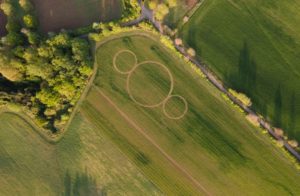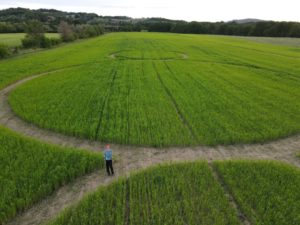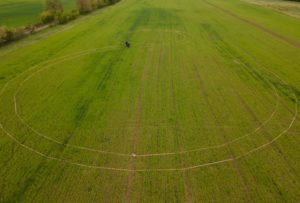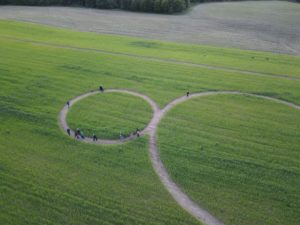Since the late 1970s, an apparent mystery has raged at global level: crop circles, areas of fields, usually of cereals, in which the plants are flattened evenly, forming different geometric figures clearly visible from above. Over time a sensationalism has been generated around this phenomenon (often revealed to be artificial), driven by the suggestion that the authors of these pictograms were presumed alien entities or unidentified flying objects. In San Lazzaro di Savena too, in the metropolitan city of Bologna, if you flew over the Parco dei Gessi, you would be able to see special crop circles, or rather, three crop circles. They are the circles of the Third Paradise, Michelangelo Pistoletto’s sign-symbol. There is no supernatural phenomenon behind this representation: last March Good Land, a young company that deals with rural regeneration through the activation of economies linked to the land and the communities that inhabit it, created this particular natural installation with the collaboration of Cittadellarte. The sign-symbol was drawn without impacting the crops, when the wheat had not yet grown. Now, months later, the result is impressive: the ears are about 80 cm high, a path in the middle of nature, an oasis where art constantly and delicately dialogues with nature. This place will be the setting for The wheat ceremony in the name of the Third Paradise, scheduled for Wednesday 30 June starting at 6 pm.


The participants who have registered for the initiative will have the opportunity to ‘immerse themselves’ on the path traced into the ripe wheat field and walk the sign of the Third Paradise. Those present will also be able to listen to the speeches of Isabella Conti (mayor of San Lazzaro), Michelangelo Pistoletto, Lucio Cavazzoni (Good Land), Francesco Tonelli (Cooperative La Fraternità), Elly Schlein (vice-president of Regione Emilia-Romagna), Tiberio Rabboni (LAG Appennino Bolognese), Luca Martinelli (journalist), Giovanni Dinelli (University of Bologna) and Silvia Vacchi (chorus Stelutis). “It will be an opportunity to talk about wheat, art, bread and the Apennines” reads the poster. After the speeches, the choir Stelutis will perform songs from Emilia-Romagna’s oral tradition, discovered and transcribed by its founder Giorgio Vacchi. At the conclusion of the event, Forno Carzolari and Forno Brisa will offer bread mixed with Good Land flours and infusions of flowers, the Cooperative Coltivare Fraternità piadine and crescioni, and Borgo Mameli tomato soups, all to be washed down with Corte d’Aibo fresh wines.




Rita Brugnara (planning and communication for Good Land) told us about the peculiarities of the wheat field that accommodates the sign of the Third Paradise: “The wheat is called ‘people’: it is not just one type of wheat but six historical varieties with different names and forms. There are ears that have awns and ears that don’t have them, for example. The plot is on the outskirts of the city, but is located inside a park, in the midst of nature, where there is no artifice, except in the symbol we have created. Since we are on a plateau, the field is flat and the only way to ‘perceive’ the Third Paradise is to walk inside it. The beauty of walking the sign-symbol at sunset with the woods behind you will be indescribable”. In addition to the introspective walk between nature and art, the organisers will explain the principles of the Third Paradise to the participants, providing them with further inputs to enrich their experience. “It will be a moment of exchange – added Rita – during which we will discuss why we have chosen to ‘make the trinamic symbol’ our own“. As mentioned, a conference will then follow: “We will talk about organic wheat, respectful and regenerative agriculture and processes that make it possible to promote the agriculture of marginal areas. As Good Land, our challenge is in fact to support small-scale agriculture, different from industrial and intensive agriculture. We need to enhance the fields – she concluded – with quality agriculture and, with this in mind, in taking care of our land we want to be inspired by the Third Paradise”.

